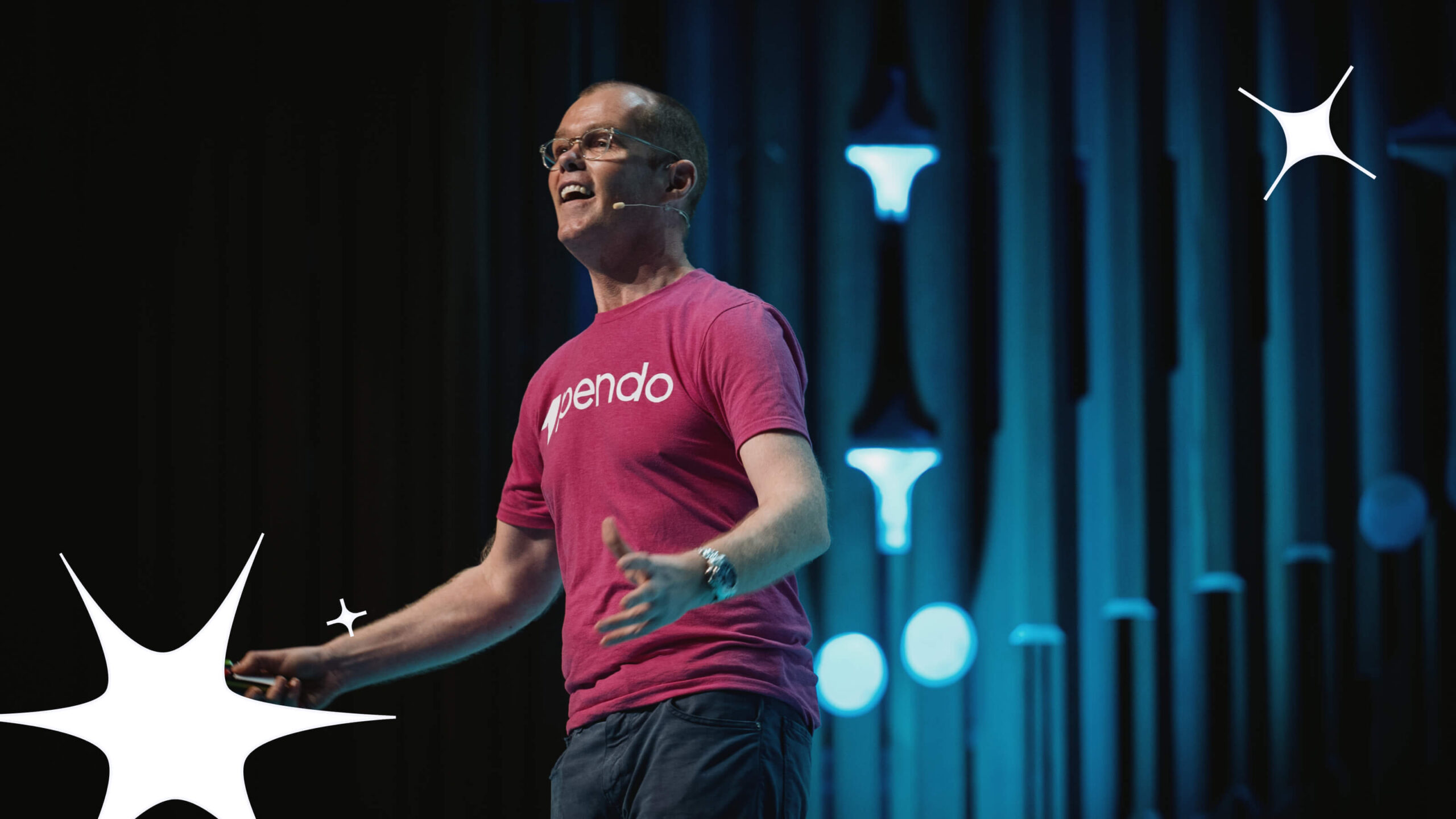Remember when you used to ship your product on floppy disks or CD-ROMs, and include a dense and cumbersome user manual in the package? How you had to send hundreds if not thousands more CDs to distribute updates?
Things have definitely changed, and it’s required companies to devise new and better ways to get their products in users’ hands and get them up to speed on how to use them as quickly as possible. One solution that many of the world’s top-performing companies have settled on is becoming product led. That’s when you center your entire organization around your product, baking support, sales, marketing, and other functions right into it so that it’s as intuitive as possible. The ideal outcome of this strategy is one in which a user can access all of those functions inside the product, entirely on their own, without having to speak to a single human.
Pendo’s Director of Product Ops, Christine Itwaru, and Senior Product Manager Dan Dalton, joined the fourth installment of our webinar series, “How to build a product-led organization in 2021,” to discuss this new way of delivering product and what it takes to become truly product led.
Rally around the product
The most fundamental step toward becoming product led is to re-align your organization to place your product at the center of everything each function and team does, so that the product becomes the sole resource users need to rely on to get their jobs done.
Your product is a treasure trove of user feedback—both the good and the bad—that can inform you of the right direction to take future development and what needs to be fixed right now, and centering your team around the product makes it easier to get that information into the right hands. Then, you have to actually act on that information and respond to your users, quickly.
Think beyond the release
Traditionally, software has been developed through a build-and-release process that drew a straight line design through development and release. That approach is not sufficient for a company that wants to become truly product led, Itwaru said.
Here at Pendo, we first test new functionality in internal beta, giving our success teams a chance to use the new feature and provide their vote of confidence that it’s something users will be able to understand and find useful. Then, we move the feature into a limited beta including users who have been pushing for that functionality the hardest, then to a more open beta, and finally to general availability. All of the feedback collected during those beta periods is used to tweak and iterate on the feature to help ensure it’s successful.
“It all takes time, but it’s time well-spent if you’re building software in this manner,” Itwaru said.
Another way to test releases without frustrating or confusing your users, many of whom have developed muscle memory for using the current iteration of your product and typically find it quite painful when even minor changes are made, is to offer an opt-out, Dalton said. This lets your user experience the new layout or features without feeling as if it’s forced on them, since they can switch back to more familiar ground at any time.
The percentage of users that opt out back to the legacy version can be a telling metric, he said. You can ask those users why they did so, refining your understanding of what levers need to be pulled to ensure a successful transition when you launch the new experience.
It’s also critical to get word out to your users post-release. Users who don’t know about new features can’t adopt them, after all, and without adequate user awareness, you can’t measure success accurately. “Making sure you consider the mechanisms you have in place to inform your customers is a really vital part of the launch process,” Dalton said.
Learn the art of letting go
Building new and better features is important to growing your business, but reducing or sunsetting those that aren’t used yet must still be maintained is a critical activity for any product team as well.
There are plenty of creative ways to get this done, Dalton said:
-
- Basecamp knew users had built deeply complex workflows around their highly successful product, so when it came time to upgrade, they built an entirely new one to make sure users didn’t lose what they already had and knew well.
- Freshbooks built an entirely separate company, cooking up their own competitor and later transitioning users over to that platform when it became successful.
- Google’s Gmail tested slightly altered versions of their inbox when redesigning the interface to see which did best.
“All of those cases are good examples of how different companies have approached being focused on continuous measurement and the need for forward motion, even if it means making hard choices and moving on from what originally got you there in the first place,” he said.
More engaged companies, more engaged users
Keeping users engaged with your product is a top priority for any company. Having good processes and tools for managing feedback is absolutely essential for doing so. Soliciting, analyzing, prioritizing, and acting on feedback is a powerful way to engage directly with your users and let them know you’re listening and working on their needs.
“Customer feedback can come from so many sources, whether it’s win-loss analysis, support tickets, customer research, customer success activities—all of that valuable insight needs a centralized home, and it needs to be easily accessible in order for it to be actionable for an entire organization,” Dalton said.
Allowing users to submit feature requests, then vote on those submitted by their peers is one good way to automate the prioritization process to some extent, Dalton said. You can also present users with pairwise voting and ask them to choose which of two features they consider more important.
You should also have a process in place for informing users why particular requests don’t get built, and make your roadmap public. “When it comes to communicating internally or externally, making sure customers and stakeholders have a place to go to understand the direction is absolutely key for engagement with your customers,” Dalton said.
Product ops is the golden thread between teams
Just as a conductor brings an orchestra together to meld the playing of hundreds of individual instruments together into a cohesive piece of music, the Product Ops team acts as the orchestrator for keeping every team in your organization and product on track, and if you haven’t stood one up yet, it’s time.
Product ops sits in the middle of product, engineering, success, and sales, ensuring alignment and empowerment to improve the customer experience. It’s no small task: They’re taking in support requests, user feedback, requests from sales reps, and roadmap and NPS reviews at all times, organizing it all, and making sure all that information lands in the laps of the right people to act on it.
Each org has different tools that they use and KPIs to report, and things can get pretty unwieldy, pretty quickly between teams, Itwaru noted. “You can have app overload, or you can have a team like mine that sits down and focuses on how to create efficiency across the board and partners with teams to make sure those things are well understood,” she said.
Weaving all of this together the perfect formula for building a true product-led organization. “The difference between good and great is that recognition of customer pain and the amount of effort and time that is well spent to deliver the best experience to them. That is the new way of delivering product. That’s what truly product led is,” Itwaru said.


